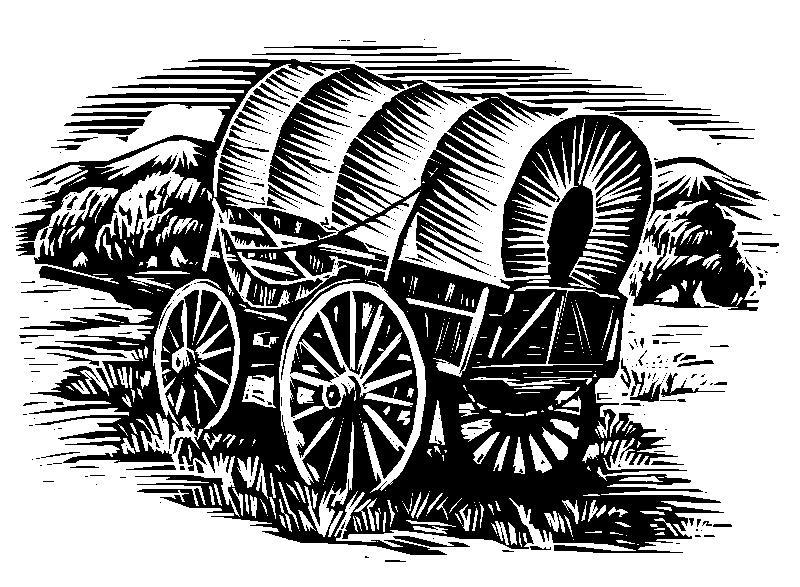

Click on map to see larger view.
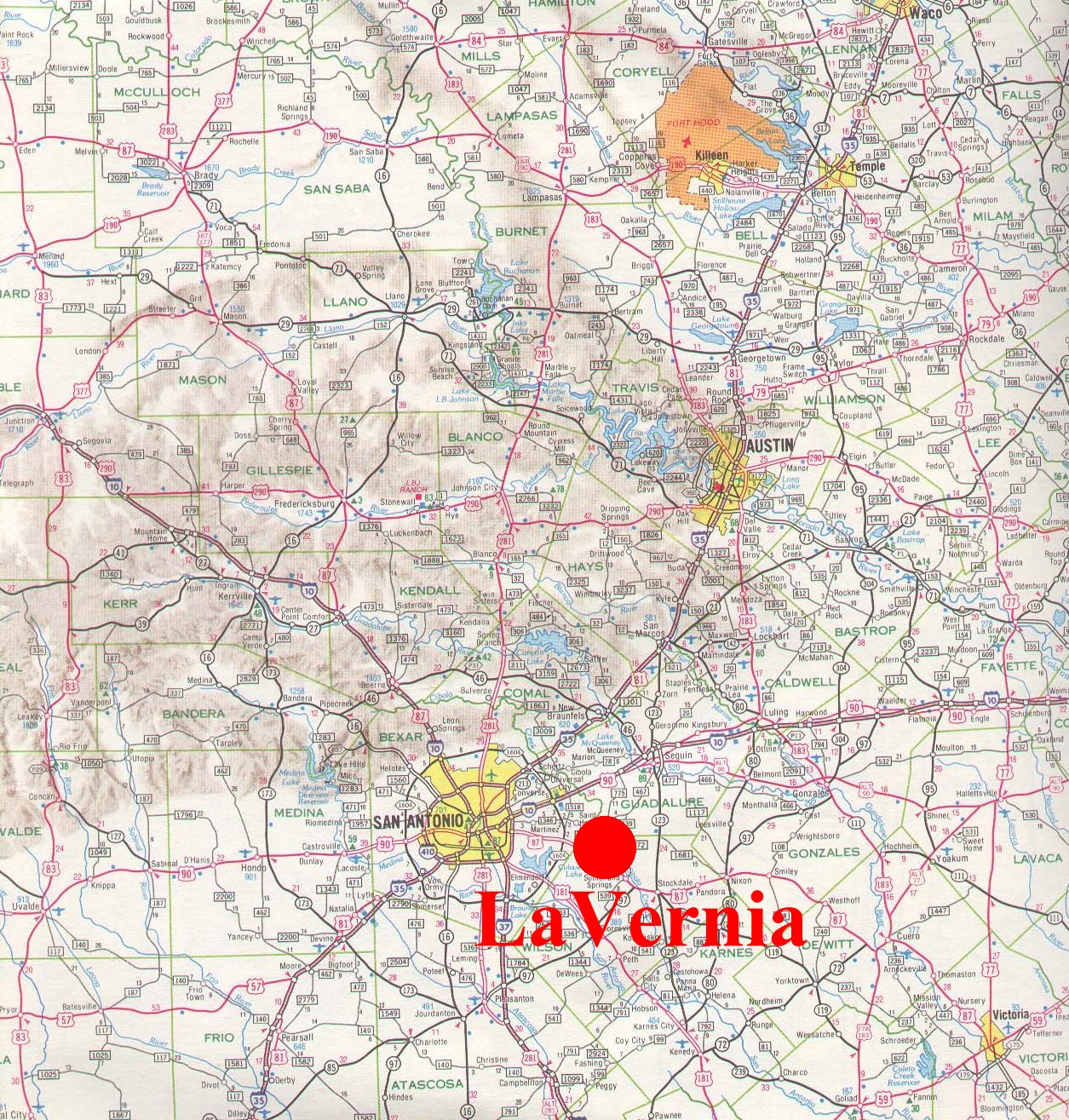
The beginning of the town of La Vernia:
In the area of present-day La Vernia, the Spaniards came to the area to begin ranching around the 1750's. They were not the first to "settle" the area. Two Native American tribes were in the area already. They were the Comanches and the Coahuiltecans. Then Anglo-Americans started to move in circa 1830's. La Vernia's history dates back to as early as 1827-1833 but due to the innumerable Indian raids, many settlers were forced to abandon their houses and farms. True settlement began around the time of 1836-1838, when a land bill for veterans of the Republican army was passed by the state. The first to settle here, according to one source, was William Claiborne Rector, more commonly known as Claiborne Rector. He was owner of most of the land which is present-day La Vernia. He built the first house out of post oak logs, which is how the town became known as Post Oak. Not only did he farm, but he was also the first postmaster of Post Oak. He also kept horses which ran the stage that ran four times daily. This route was known as "Chihuahua Road," which is still in La Vernia today, and ran from Indianola all the way to San Antonio. From there, it connected with the San Diego Mail Line to California. This small settlement was called Post Oak until a government mail service was started in February of 1853, when they discovered that there was another town called Post Oak in Jack County.
Important men in the founding of La Vernia:
Several families came from Mississippi and settled here on land that soon became plantations, bringing their slaves along. Most of these men took good care of their slaves by building them nice cabins to live in and keeping them fed, and in good health. Here are the stories of such men.
Claiborne Rector was born in Alabama on September 28, 1802. He moved to Texas in January of 1830 and settled in the area that is now known as Brazoria County. He enlisted in the army under David Murphee's company, which was the Second Regiment of Sam Houston's army. He was a participant in the Battle of San Jacinto. He later served in Byrd Lockhart's spy company and remained in the Texas Army until September 1, 1836. In 1840, he settled in what is now known as Wilson County. He represented Wilson County at the Secession Convention in 1861. He became Captain of the Cibolo Guards Light Infantry during the Civil War. He died on March 23, 1873, and was buried at the Concrete Cemetery in Wilson County, Texas.
William Robert Wiseman was born in Laurens County, South Carolina on February 22, 1816. In 1839, he married and had two sons, James Oliver and Hugh William. His wife died in 1845. William married Isabel Elizabeth Bell and she bore him a daughter, who died on the way to Texas. The Wisemans moved to Starksville, Mississippi, but soon left for Texas. Because they were very religious, they would always rest on Sunday in order for them to have a family time of worship. Their final stop brought them to Cibolo where they met a faithful Presbyterian, William Claiborne Rector. Wiseman bought 500 acres of land for $1,000. Upon those 500 acres, he began farming and raising his livestock. One fellow churchman said this of Wiseman "by energy and industry and perseverance, he was successful in all his undertakings." Wiseman lived in a log cabin about a mile north of La Vernia.
Erastus Smith, more commonly known by his friends as "Deaf" Smith, was given a special land grant by the Mexican government after he married a Mexican citizen. This land grant was for a Spanish league, which is 4,428 acres. This land was on the Cibolo River in the Bexar district, just a few miles from San Antonio.
In 1836, Smith was authorized to organize and command a company of Rangers. On February 15, 1837, W. S. Fischer, Secretary of War, gave orders to go lay claim on Laredo. After this famous expedition, known as the Laredo Expedition, Captain Smith retired from the service due to his failing health. He left his family in San Antonio and went to Richmond, Fort Bend County, Texas. There he died of tuberculosis on November 30, 1837 at the age of 50. Nearly a century later, the State of Texas erected a monument in Richmond. Near the top is a bronze relief bust of Erastus Smith.
James Newton came from Mississippi. He owned a plantation on which he built log cabins for his slaves. The cabins were extensions from his house that went all the way from atop a hill to the river. The lumber used to build these cabins was brought in from Port Lavaca. Due to the scarcity of nails, wooden pins were used to hold the house together.
Pendleton Rector, brother of Claiborne Rector, was probably the first to settle in the area surrounding present day La Vernia. He moved from San Marcos with his family in 1848.
The economy and culture of La Vernia, both past and present:
La Vernia has been and is a major agricultural town, and residents raised cattle and grew corn and cotton. Back when La Vernia was a young town, the main crop was corn. They grew it because they could eat it, they could feed it to their animals, or they could sell it. Now, they still grow corn but they are now growing cotton.
La Vernia's culture is was mostly Anglo-American up until the 1850's when German and Polish settlers started to settle here. La Vernia is still mostly Anglo-Saxons (51.1 percent of the population) but there are many Hispanics (35.6 percent) and African-Americans (1 percent). Native Americans are only about 0.2 percent of the population, Asians are 0.1 percent, and all others make up 11.9 percent of the population.
Historical landmarks of La Vernia:
One landmark that has been around since 1858 is the Masonic Hall. it was originally erected for three purposes. One was for a school, which was held on the first floor. The second was for public worship. The third purpose was for Masonic meetings, which were held on the second floor.
Another landmark is the La Vernia United Methodist Church. Rev. J. S. McGee of Seguin, a circuit rider, began to preach near present-day La Vernia. In 1871, the Masons completed their lodge in La Vernia, where school and church services were held. During 1876-1877, Rev. John E. Vernor organized the La Vernia Methodist Episcopal Church, South. In 1881, Rev. W. T. Thornberry was pastor of the church when the congregation bought 1.5 acres of land, where they erected the church. The first resident pastor was Rev. F. A. Knox. Sadly, on August 20, 1886, the chapel was blown down by a storm caused by a Gulf hurricane. Members quickly began work on building a new chapel on the same site. This makes the current chapel over 100 years old. In 1950, the church added a beautiful stained-glass window to the church, which they call "Good Shepherd." Church members recently moved the old church to a new location just down the road due to the increase in membership. They now use it as a Sunday School class room, but mainly it is a prayer chapel. All of the church members receive a key to the prayer chapel and can come to the chapel to pray 24 hours a day, seven days a week.
Another landmark is Rector Chapel. This church was started by William Wiseman and Claiborne Rector. This was a Presbyterian church that was originally called Presbyterian Church at the Cibolo. The name was later changed to Rector Chapel. The church was made entirely out of wood and cost around $1,200. Some of the original members included Claiborne Rector, I. F. Tiner, Mary A. Tiner, William Wiseman and Elizabeth Wiseman.
In 1877, the church was moved to La Vernia and was called the La Vernia Presbyterian Church. Today the church still stands, but is now being used by the Primitive Baptists. This was agreed upon by Herron Wiseman and the Baptist Church.
Various events that took place in La Vernia:
In 1878, Will Irvin and George Seekers fought a duel. It all started over a comment Irvin said to a lady, who happened to be a friend of Seekers'. Both men were not on good terms so Seekers took the comment as a personal insult to his lady friend. At the duel, neither of the two men was hurt by their first shots. The second shots killed them both. Irvin was married and had several children, while Seekers was not married.
In August of 1908, George Toms and Emil Lenz were killed in the Koepp and Lenz Saloon. A few days before their deaths, there had been a drunken brawl in the saloon. Several men beat George Toms severely. He went home to recover so he could come back and get even. In about a week, he had recovered enough to walk. He carried two pistols with him, and left a shotgun and a rifle in his buggy. He took one of his sons inside with him and left two others in the buggy. The fighting started when he went inside. There were several men in the saloon at the time but they escaped injury. Lenz and Toms were killed in an exchange of pistol and shotgun shots.
In 1869, the Indians made many raids in the La Vernia area. Winter was approaching and this meant that the Indians would be coming down out of the mountains and into the low areas.
One Indian raid account states that a white man and a Negro boy were out riding. The white man was riding a horse and the Negro was riding a mule. When the Indians started to approach, the mule refused to move. The Indians began to shoot and the white man left the boy. The Indians captured the boy and killed him. They then pursued the white man, but he had gone to town to give the alarm. Immediately a band of men, led by Creed Taylor, caught up with the Indians near the old depot. The Indians carried rifles and there was about 30 of them at the time. Considering their odds, most of the men withdrew. Taylor, an Indian fighter and a very brave man, pulled out his six-shooter and killed several of the Indians. The Indians released the boy's body.
A few years later, the Indians made another raid and stole about 30 head of horses. Taylor organized a band of men and started the pursuit. After trailing the Indians for about 10 miles, they lost the trail. Many of the men turned back, but not Taylor, who lost his prized racing mare, was very determined. The men came upon the Indians at a crossing known as Indian Crossing, where the highway crosses the river between Stockdale and La Vernia. The men hid in the bushes until the Indians had their camp all set up and settled in for the night. It is customary for the Indians to herd the horses into a small space and make their beds around them. That is exactly what they did. Taylor, who was very brave, crept through the line of Indians and untied all of the horses. He got on his mare, turned his horse towards La Vernia, fired his pistol, and headed home. The other horses followed close behind.
Another Indian raid resulted in the death of Mr. Applewhite. Mr. Applewhite had gone to the river to look after his garden and cattle. As he was returning home, Indians ambushed him. They killed him and left him. Some men who were riding from San Antonio, found his body and carried it to his home.
The great flood of Oct. 1, 1913 flooded all of La Vernia, from the railroad to the river. The people living in this low-lying area were forced to flee to higher ground. There was no warning of the rising water, so people went to sleep as usually on September 30, 1913. Many people were awakened by water on their beds. People were wading in water almost over their heads trying to reach higher ground.
The flood of December 1, 1913 was less severe but still caused a lot of damage. The river never came out of its banks but people took their belongings and livestock to higher ground because no one wanted to experience the same catastrophes as they had just two months earlier.
The town of La Vernia was considered completely devastated by the storm of 1886. This is the storm that destroyed the Methodist Church. The surrounding countryside was considerably damaged and most of the crops were destroyed. The cotton and corn crops were almost completely destroyed. Many of the buildings around town and many farm buildings lost roofs or, worse, were destroyed. The storm, which was brought on by a Gulf hurricane, consisted of high winds, lots of hail and driving rain.
During the 1925 drought, nothing was planted. For seven months there was not a drop of rain. Then, on August 8, 1925 it rained. Up until that time, people had to buy the feed for their animals.
Interviews with people from La Vernia:
I talked to two people whose family has been a part of La Vernia's history since it began. The
first person I talked to was Mrs. Juanita Wiseman Grubbs. She is the great-granddaughter of
William Robert Wiseman. She said, "La Vernia's history dates back to as early as 1827. A few
settlers were living here but due to the Indian raids, they finally moved away, probably to the
Gonzales area. About 1836 permanent settlers began moving in from Indianola or the Carolinas...
Among one of the settlers was William Claiborne Rector... Another settler coming from South
Carolina, by wagon train was William Robert Wiseman... The main mode of transportation was wagons.
It took two days to go to San Antonio... The other form was trains. The first railroad was known
as the Gulf Shore. It was a big attraction in La Vernia... We would go to the depot and watch
the trains come and see them pick up mail bags, which was delivered to the post office... At one time we
had three doctors, Dr. Morgan, Dr. Houston, and Dr. Garrison."
Then I talked to Mr. Gary W. Shank, the son of Mrs. Juanita Grubbs. He told about La Vernia when
he was growing up. One of the things he remembers is how on Saturdays, the men would go into
town and they would drink sodas and talk. He said, "I can remember hearing German and Polish
being spoken quite frequently." He told me that where they lived you could see the train depot. He never
got to go over there but he could see the men unloading mail and various other things. He told me about
a doctor that he knew. His name was Dr. Martin. He said he had a practice for a good part of
50 years and then retired. There is even a street named after him. He also told me about what was
the main crop of La Vernia back then. He said it was corn, "because it could be used to feed you chickens
and your cattle. You could eat it or you could sell it at the market."
Photographs I borrowed or took while I was researching La Vernia:
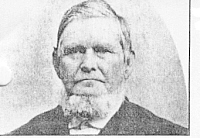
William Robert Wiseman: one of the founding fathers.
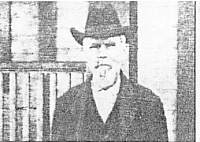
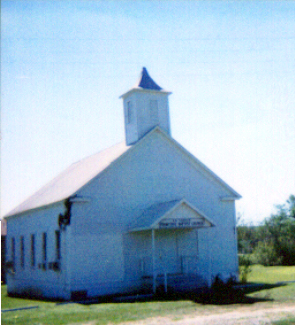
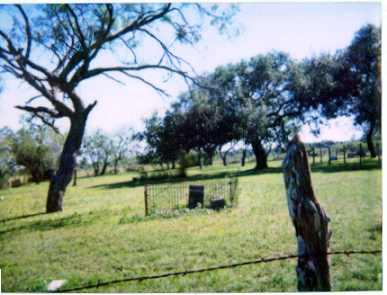 The Concrete Cemetery, built by James Henry Newton, was made entirely out of concrete. W. R. Wiseman fenced off an area for the Wiseman's. This might be that area.
The Concrete Cemetery, built by James Henry Newton, was made entirely out of concrete. W. R. Wiseman fenced off an area for the Wiseman's. This might be that area.
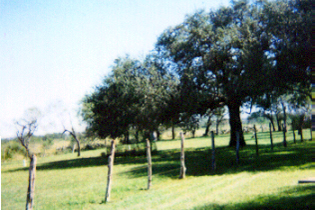 This is a different area of the Concrete Cemetery.
This is a different area of the Concrete Cemetery.
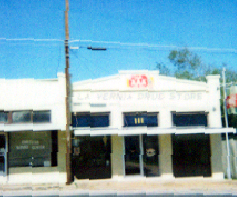 This is the drugstore in La Vernia along Chihuahua Road.
This is the drugstore in La Vernia along Chihuahua Road.
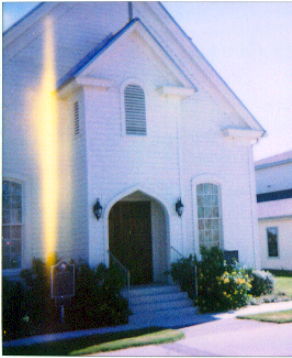 This is the old La Vernia United Methodist Church. It has been moved from its original location, due to growth in the church.
This is the old La Vernia United Methodist Church. It has been moved from its original location, due to growth in the church.
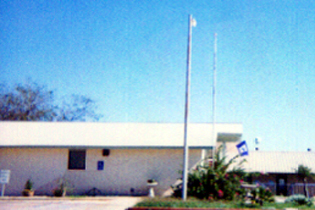 This is the original post office in La Vernia. It is now a salon. The new post office is near the elementary school.
This is the original post office in La Vernia. It is now a salon. The new post office is near the elementary school.
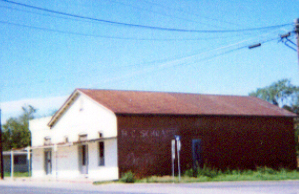 This is one of a few old buildings still standing along Chihuahua Road. It was once a store that sold antiques and trinckets. Now it looks pretty empty.
This is one of a few old buildings still standing along Chihuahua Road. It was once a store that sold antiques and trinckets. Now it looks pretty empty.
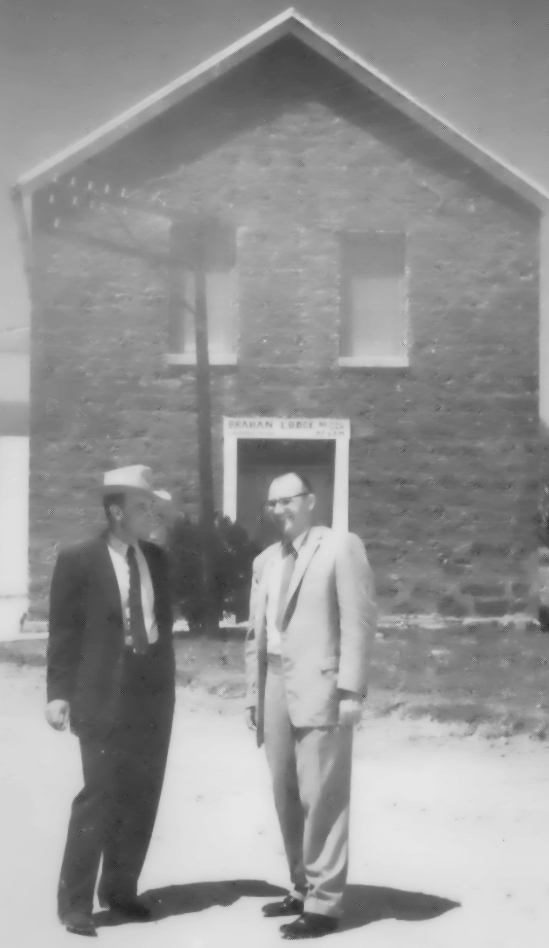 Charles Elam Scull, at the Masonic Lodge, with D. L. Vest
Charles Elam Scull, at the Masonic Lodge, with D. L. Vest
Ties to the Community:
The only ties I have to the town of La Vernia is that Mr. Gary W. Shank married my aunt. My great-grandparents have lived on the outskirts of La Vernia for many years.
F. Y. I. (Extra tidbits of information you might find interesting!): In 1877 Mr. G. W. Suttles came to Texas from Zanesville
Ohio and started a pottery factory. The Erskin building was bought and the factory began. They made things such as jugs, pans, crocks, flowerpots, and even bricks. The ware was taken to surrounding cities
such as San Antonio, Sequin, Floresville and Stockdale. The Temperance Society was established in 1870. It was the first organized society in La Vernia. It was sometimes called the "Band of Hope."
They were called this because most of its members hoped no saloons would ever be built here. They met at the Masonic Lodge and would sing songs. Mrs. Cruse, a devout Christian, looked out for the spiritual
welfare of the society. One final tidbit of information is a historical place. This place is called the Polly Mansion. It was built by Dr. J. G. Houston, whose house was just east of William Wiseman's house. It was a place for settlers to stay while their houses where being built.
Check out these websites for more information on La Vernia:
The "Glass League" was an enormous tract of fertile land, which lies west of La Vernia. A man named Glass owned this territory. He divided this land into separate farms and sold it to settlers.
Later on this land was said to have about a dozen active and productive farms on it. Not one of the farms had less than 100 acres on it.
Annotated Bibliography:
Bryan, J. L. "Rector Claiborne." The New Handbook of Texas. vol.4. Austin: The Texas State Historical Association, 1996.
Gilliand, Maude. Wilson County Texas Rangers. Wilson County: 1971.
Grubbs, Juanita Wiseman. Personal interview. 26 Oct. 2000.
Hazelwood, Claudia. "La Vernia, Texas." The New Handbook of Texas. vol. 4. Austin: The Texas State Historical Association, 1996.
"La Vernia." The Encyclopedia of Texas. vol. 1. Michigan: Somerset Publishers, 1999.
"La Vernia." Wilson County Centennial. Floresville: Wilson County Centennial Association, 1960.
"La Vernia." Wilson County History. Dallas: Taylor Publishing Company, 1990.
"La Vernia United Methodist Church." Wilson County History. Dallas: Taylor Publishing Company, 1990.
"Masonic Hall at La Vernia." Wilson County Centennial. Floresville: Wilson County Centennial Association, 1960.
"Rector Chapel." Wilson County History. Dallas: Taylor Publishing Company, 1990.
Shank, Gary W. Personal Interview. 26 Oct. 2000.
Vest, D. L. A Century of Light. Ft. Worth: Printing Department of the Masonic Home and School, 1959.
"William Robert Wiseman." Wilson County History. Dallas: Taylor Publishing Company, 1990.
"Wilson County." Texas Almanac. Millenium ed. Dallas: The Dallas Morning News, 1999.
Provides a brief history his of life before Texas; documents historical significance to La Vernia, Texas; excellent source; needs nothing.
Gave a well written biography of Erastus Smith; excellent resource; needs nothing else.
Documents the history of La Vernia; provides information on different ethnic groups that settled in La Vernia; good source; could be more detailed.
Gives very brief history of La Vernia; used it mainly as a reinforcement for the other sources; needs more information.
Gave history of La Vernia; gave accurate accounts of events; great resource; needs nothing.
Documents the first settlers in La Vernia; describes the important people in the founding of La Vernia; tells of the Indian raids; wonderful resource; lacks nothing.
Provides information on the beginnings of the Methodist church in La Vernia; gives history of the historical church; lists major people involved in the church's history; great resoudce; lacks nothing.
Gave brief account of purpose; gave account of key people in the making of the building; great source; needs nothing.
Describes reason church was built; gives major figures involved in the building of the church; good source of information; lacks nothing.
Discusses the history of the Masons in La Vernia; tells of the key Masons in the history of La Vernia; very detailed resource; lacks nothing.
Gives family history of william Wiseman; great source; lacks nothing.
Gave statistics for present-day La Vernia; gave a brief history of La Vernia; great resource; lacked nothing.